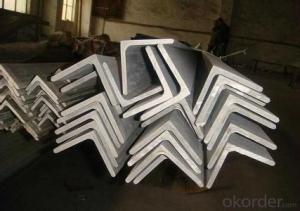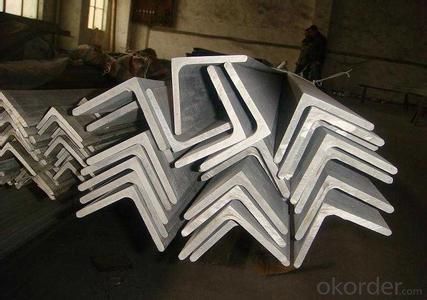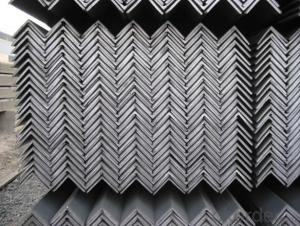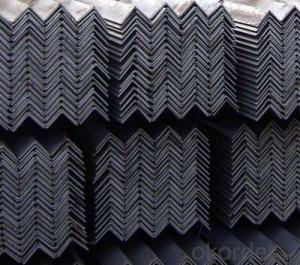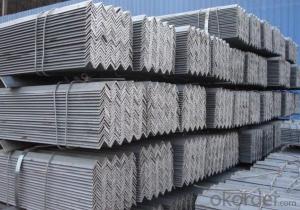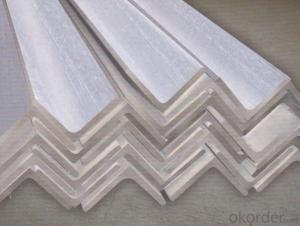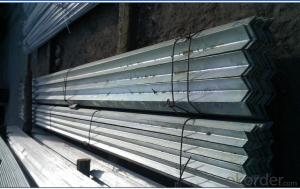ANGLE STEEL 30MM
- Loading Port:
- China Main Port
- Payment Terms:
- TT OR LC
- Min Order Qty:
- -
- Supply Capability:
- -
OKorder Service Pledge
OKorder Financial Service
You Might Also Like
Angle Steel Details:
| Minimum Order Quantity: | 25mtons | Unit: | m.t. | Loading Port: | China Main Port |
| Supply Ability: | 80000-100000MTS/YEAR | Payment Terms: | TT or LC |
Product Description:
Specifications of Angle Steel
1. Invoicing on theoretical weight or actual weight as customer request
2. Length: 6m, 9m, 12m as following table
3. Sizes
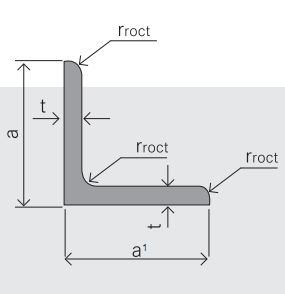
Sizes: 25mm-250mm | ||
a*t | ||
25*2.5-4.0 | 70*6.0-9.0 | 130*9.0-15 |
30*2.5-6.6 | 75*6.0-9.0 | 140*10-14 |
36*3.0-5.0 | 80*5.0-10 | 150*10-20 |
38*2.3-6.0 | 90*7.0-10 | 160*10-16 |
40*3.0-5.0 | 100*6.0-12 | 175*12-15 |
45*4.0-6.0 | 110*8.0-10 | 180*12-18 |
50*4.0-6.0 | 120*6.0-15 | 200*14-25 |
60*4.0-8.0 | 125*8.0-14 | 250*25 |
5. Payment terms:
1).100% irrevocable L/C at sight.
2).30% T/T prepaid and the balance against the copy of B/L.
3).30% T/T prepaid and the balance against L/C
6.Material details:
Alloy No | Grade | Element (%) | | ||||
C | Mn | S | P | Si | | ||
| | |||||||
|
|
|
|
|
|
| |
Q235 | B | 0.12—0.20 | 0.3—0.7 | ≤0.045 | ≤0.045 | ≤0.3 | |
|
|
|
|
|
|
| |
Alloy No | Grade | Yielding strength point( Mpa) | | ||||
Thickness (mm) | | ||||||
≤16 | >16--40 | >40--60 | >60--100 | | |||
≥ | | ||||||
|
|
|
|
|
| | |
Q235 | B | 235 | 225 | 215 | 205 | | |
Alloy No | Grade | Tensile strength (Mpa) | Elongation after fracture (%) | | |||
Thickness (mm) | | ||||||
| ≤16 | >16--40 | >40--60 | >60--100 | | ||
≥ | | ||||||
|
|
|
|
|
|
| |
Q235 | B | 375--500 | 26 | 25 | 24 | 23 | |
Usage & Applications of Angle Steel
According to the needs of different structures, Angle can compose to different force support component, and also can be the connections between components. It is widely used in various building structures and engineering structures such as roof beams, bridges, transmission towers, hoisting machinery and transport machinery, ships, industrial furnaces, reaction tower, container frame and warehouse etc.
Packaging & Delivery of Angle Steel
1. Packing: it is nude packed in bundles by steel wire rod
2. Bundle weight: not more than 3.5MT for bulk vessel; less than 3 MT for container load
3. Marks:
Color marking: There will be color marking on both end of the bundle for the cargo delivered by bulk vessel. That makes it easily to distinguish at the destination port.
Tag mark: there will be tag mark tied up on the bundles. The information usually including supplier logo and name, product name, made in China, shipping marks and other information request by the customer.
If loading by container the marking is not needed, but we will prepare it as customer request.
Production flow of Angle Steel
Material prepare (billet) —heat up—rough rolling—precision rolling—cooling—packing—storage and transportation
- Q: Are steel angles affected by vibration?
- Yes, steel angles can be affected by vibration. When subjected to constant or repetitive vibrations, steel angles can experience fatigue or stress cracking over time. This is because vibrations, especially those of high frequency or amplitude, can induce dynamic loads on the steel angles. These loads can lead to cyclic stresses and strains, which can eventually cause damage to the material. In some cases, excessive vibrations can also cause the steel angles to resonate, resulting in amplified oscillations that can lead to structural failure. It is important to note that the susceptibility of steel angles to vibrations depends on various factors such as the quality and strength of the steel, the magnitude and frequency of vibrations, and the design and installation of the structure. To mitigate the effects of vibration on steel angles, engineers and designers often employ various techniques such as damping systems, vibration isolation, or reinforcing the structure to increase its resistance to dynamic loads. Regular inspections and maintenance are also crucial to identify and address any potential issues caused by vibrations to ensure the structural integrity and longevity of steel angles.
- Q: What are the common welding techniques for steel angles?
- Some common welding techniques for steel angles include: 1. Shielded Metal Arc Welding (SMAW): Also known as stick welding, SMAW is a popular technique for welding steel angles. It involves using a consumable electrode coated in flux, which creates a protective shield around the weld pool. SMAW is versatile and can be used for various thicknesses of steel angles. 2. Gas Metal Arc Welding (GMAW): This technique, also known as MIG welding, uses a continuous wire electrode and a shielding gas, typically a mixture of argon and carbon dioxide. GMAW offers high welding speeds and good control over the weld pool, making it suitable for welding steel angles. 3. Flux-Cored Arc Welding (FCAW): Similar to GMAW, FCAW uses a continuous wire electrode, but instead of a shielding gas, it utilizes a flux-filled wire. This flux creates a protective gas shield when heated, preventing contamination of the weld. FCAW is ideal for outdoor welding or in windy conditions. 4. Gas Tungsten Arc Welding (GTAW): Also known as TIG welding, GTAW uses a non-consumable tungsten electrode and a shielding gas, usually argon. GTAW is a precise and clean welding process that produces high-quality welds on steel angles. It is commonly used for thin steel angles or when aesthetics and control are crucial. 5. Submerged Arc Welding (SAW): SAW is a semi-automatic or automatic welding process that involves feeding a continuous wire electrode and a granular flux into the weld zone. The flux covers the weld, preventing atmospheric contamination. SAW is often used for thicker steel angles and provides high deposition rates. It is important to choose the appropriate welding technique based on the specific requirements of the steel angle joint, such as thickness, joint design, and desired weld quality. Additionally, proper preparation, including cleaning and preheating if necessary, is essential to ensure successful welds on steel angles.
- Q: How do you calculate the buckling strength of a steel angle?
- To calculate the buckling strength of a steel angle, several factors need to be considered. The buckling strength refers to the ability of the angle to resist buckling or collapse under applied loads. Firstly, the geometry of the steel angle must be determined. This includes the dimensions of the angle, such as the length of the legs and the thickness of the steel. Additionally, the cross-sectional properties, such as the moment of inertia and the section modulus, need to be calculated. Next, the effective length of the angle needs to be determined. The effective length is a measure of how restrained the angle is against buckling. It depends on factors such as the boundary conditions and the connection details. The effective length can be different for different modes of buckling, such as flexural or torsional buckling. Once the effective length is determined, the critical buckling load can be calculated using an appropriate buckling equation. There are several buckling equations available, depending on the boundary conditions and the mode of buckling. For example, the Euler buckling equation can be used for long, slender angles subjected to axial compression. Other equations, such as the Johnson buckling equation, may be used for more complex loading scenarios. The critical buckling load can then be converted to an allowable stress using a suitable safety factor. The safety factor accounts for uncertainties in the calculation and ensures that the angle can safely carry the applied load without buckling. The safety factor is typically specified by design codes or industry standards. In summary, calculating the buckling strength of a steel angle involves determining the geometry and effective length of the angle, applying an appropriate buckling equation, and converting the critical load to an allowable stress using a safety factor. It is important to consult relevant design codes and standards to ensure accurate and safe calculations.
- Q: How do steel angles behave under seismic forces?
- The behavior of steel angles under seismic forces varies depending on their design, size, and connection details. Generally, steel angles are commonly utilized in seismic-resistant structures because they can dissipate energy and withstand lateral forces. Here are several important characteristics regarding the behavior of steel angles under seismic forces: 1. Ductility: Steel angles possess a high level of ductility, allowing them to undergo significant deformations without failure. This characteristic is crucial in seismic design as it enables the structure to absorb and dissipate energy during an earthquake, thereby preventing sudden collapse. 2. Flexibility: Steel angles have the ability to flex and bend when subjected to seismic forces, which enables them to absorb energy and minimize the impact on the overall structure. This flexibility aids in distributing the seismic forces evenly throughout the structure, reducing localized damage. 3. Connection behavior: Proper connection design is vital to ensure the performance of steel angles under seismic forces. The connections must be designed to allow for rotation and accommodate the anticipated displacements during an earthquake. Adequate connections prevent the angles from becoming brittle or failing prematurely. 4. Buckling resistance: Steel angles are prone to buckling under compression forces. To enhance their resistance to buckling, lateral bracing or stiffeners are often utilized. These components offer additional support to the angles and help prevent buckling during seismic events. 5. Strength and stiffness: Steel angles possess high strength and stiffness, enabling them to withstand the lateral forces induced by an earthquake. The strength of steel angles can be enhanced by selecting appropriate materials, such as using higher-grade steel with greater yield strength. In conclusion, steel angles are well-suited for seismic-resistant structures due to their ductility, flexibility, and strength. However, their behavior under seismic forces is heavily dependent on proper design, connection details, and adherence to seismic codes and standards. It is crucial to consult with structural engineers and follow best practices to ensure the optimal performance of steel angles in seismic design.
- Q: How do you clean steel angles?
- To clean steel angles, you can start by removing any loose dirt or debris with a soft brush or cloth. Then, mix a solution of mild detergent and warm water and use a sponge or cloth to gently scrub the surface. Rinse the angles thoroughly with clean water and dry them with a clean cloth to prevent any water spots or rusting.
- Q: Can steel angles be welded or joined together?
- Steel angles are capable of being welded or joined together. Welding is a frequently utilized technique for connecting steel angles, as it establishes a robust and long-lasting bond. This procedure entails melting the edges of the angles and subsequently fusing them using a welding electrode. By means of welding, a secure connection is not only formed between the steel angles but structural integrity is also guaranteed. To maintain the joint's quality and strength, it is imperative to adhere to appropriate welding procedures and techniques. Furthermore, depending on the particular application and requirements, steel angles can also be connected using alternative methods such as bolting or riveting.
- Q: How do steel angles contribute to energy-efficient construction?
- There are multiple ways in which steel angles play a role in energy-efficient construction. To begin with, steel angles are frequently utilized as structural elements in buildings, particularly for framing walls, roofs, and floors. Their excellent strength-to-weight ratio enables the construction of lighter and more efficient structures. This means that less steel is required to support the building, resulting in reduced overall weight and material usage. Consequently, this leads to a decrease in the energy needed for construction and transportation. Furthermore, steel angles can be easily prefabricated off-site, which allows for quicker construction times and lower labor costs. This not only saves time and money but also reduces energy consumption during the construction process. Moreover, steel is an incredibly durable and long-lasting material, which reduces the necessity for frequent maintenance and repairs. This durability translates into energy savings throughout the building's lifespan, as less energy is required for ongoing maintenance and replacements. Additionally, steel angles can be recycled when they reach the end of their life cycle. This reduces the demand for new materials and minimizes the environmental impact of construction. The recycling process requires less energy compared to the production of new steel, resulting in energy savings and reduced greenhouse gas emissions. Lastly, steel angles can be integrated into energy-efficient building systems, such as insulation, HVAC ductwork, and renewable energy installations. The versatility of steel allows for the creation of systems that optimize energy performance, such as efficient heating and cooling systems or solar panel installations. In conclusion, steel angles contribute to energy-efficient construction through their strength and stability, reduced material usage, faster construction times, minimized maintenance needs, recycling capabilities, and integration with energy-efficient building systems.
- Q: Can steel angles support heavy loads?
- Yes, steel angles can support heavy loads due to their structural strength and durability. They are commonly used in construction and engineering projects to provide stability and support for various applications.
- Q: Can steel angles be used in the construction of solar panel support structures?
- Yes, steel angles can be used in the construction of solar panel support structures. Steel angles are commonly used in the construction industry due to their strength and durability. They provide excellent support and stability, which is crucial for solar panel installations. Steel angles can be easily welded or bolted together to create strong and rigid structures that can withstand the weight of solar panels and the various environmental factors they may be exposed to, such as wind and snow loads. Additionally, steel angles can be customized to meet the specific design requirements of the solar panel support structure, making them a versatile choice for construction projects.
- Q: What are the considerations for selecting the appropriate steel angle thickness?
- When considering the appropriate thickness for a steel angle, there are multiple factors to take into account. Firstly, the project's structural requirements are of utmost importance. This includes assessing the load-bearing capacity, support requirements, and adherence to specific design codes or standards. The chosen steel angle thickness should guarantee the structural integrity of the project. The application of the steel angle also plays a crucial role in determining the suitable thickness. Different applications have varying demands in terms of strength, durability, and resistance to environmental factors. For instance, if the steel angle will be used in a corrosive environment, a thicker thickness may be necessary to provide enhanced protection against corrosion. Cost-effectiveness is always a significant consideration in construction projects. While thicker steel angles may offer greater strength and stability, they can also be more expensive. Striking a balance between the required strength and the available budget is essential for ensuring cost-effectiveness. Furthermore, the selected steel angle thickness should align with the manufacturing and fabrication capabilities of the manufacturer. It is important to consider the availability of the desired thickness and the feasibility of producing the required dimensions. In some cases, the appearance of the steel angle may also be a factor to consider. Thicker angles can have a more substantial and visually appealing look, which can be desirable in certain architectural or design applications. The availability of steel angles in different thicknesses and standard sizes can also influence the selection process. Opting for a thickness that is readily available in the market is often more convenient and cost-effective. To conclude, selecting the appropriate steel angle thickness involves careful consideration of structural requirements, application demands, cost-effectiveness, manufacturing limitations, aesthetic preferences, and the availability of standard sizes. By taking all these factors into account, an informed decision can be made to meet the project's needs and ensure the desired level of strength and durability.
Send your message to us
ANGLE STEEL 30MM
- Loading Port:
- China Main Port
- Payment Terms:
- TT OR LC
- Min Order Qty:
- -
- Supply Capability:
- -
OKorder Service Pledge
OKorder Financial Service
Similar products
Hot products
Hot Searches
Related keywords
